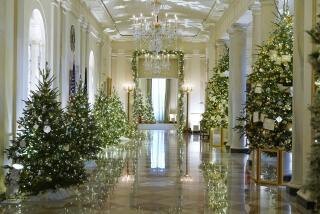COLLECTIONS : Diversity of American Crafts Seen in White House Collection
- Share via
The White House Collection of American Craft, meant to draw attention to the diversity of contemporary crafts in this country, comprises 72 glass, ceramic, metal, wood and fiber objects.
The collection, on display at the National Museum of American Art in Washington through Sept. 4, is accompanied by a book published by Abrams ($35) and an electronic tour via the Internet.
At the end of the show, the collection will return to the White House and, ultimately, to the Clinton Presidential Library, wherever it may be.
The pieces, most donated by the artists, have been displayed on a rotating basis in the Clinton family quarters.
A favorite, a glass bowl by Dale Chihuly, stood on a table in the Center Hall.
The collection was assembled by Michael W. Monroe, curator in charge of the museum’s Renwick Gallery, in consultation with Hillary Rodham Clinton in an attempt to demonstrate the diversity of American crafts in the 1990s.
Indicative of divisions in the American crafts world, it is equal parts functional, quasi-functional and purely decorative.
Some of the craftsmen are self-taught. Some learned from a parent or as apprentices. Others went to art school.
“We wanted to represent the spectrum of American crafts, from blue-chip names to emerging artists, a wide geographic area, both genders, youth and age, and many ethnic strains,” Monroe says.
Although this is the first named White House crafts collection, it is not the first time the White House has promoted American crafts.
In 1882, President Chester A. Arthur commissioned Louis Comfort Tiffany to create a colored glass screen for the Cross Hall.
In 1913, Ellen Wilson set up a Blue Mountain Room and invited people to come in and place orders for textiles woven in the mountains of North Carolina and Tennessee.
In 1927, Eleanor Roosevelt furnished a bedroom with colonial revival pieces made by a small workshop in Hyde Park, N.Y., known as Val-Kill Industries.
In 1977, Rosalyn Carter used handcrafted tableware for the Senate wives’ annual luncheon. When George Mondale was vice president, his wife, Joan, a potter, filled their official residence with crafts. She is among the artists represented in the White House show.
Now, what’s this about the Internet?
Anyone with a computer, modem and hookup to the Internet through one of the on-line services will be able to access images and text of the exhibition, including a clip about each artist and a history of the White House room where each object is installed. The user may also leave messages for the White House, the curators of the exhibition and the artists.
“Potentially, there are millions of homes that we could reach,” says Steve Dietz, chief of publications and new media initiatives at the National Museum of American Art.
Why leave home, then?
“The Internet version of the tour is more like an electronic book than it is like a visit to the exhibition,” Dietz says. “Ideally, someone will see the show and the Internet.”
*
The National Museum of American Art, 8th and G streets, N.W., Washington, D.C., is open from 10 a.m. to 5:30 p.m. daily. Admission is free of charge.
More to Read
The biggest entertainment stories
Get our big stories about Hollywood, film, television, music, arts, culture and more right in your inbox as soon as they publish.
You may occasionally receive promotional content from the Los Angeles Times.










